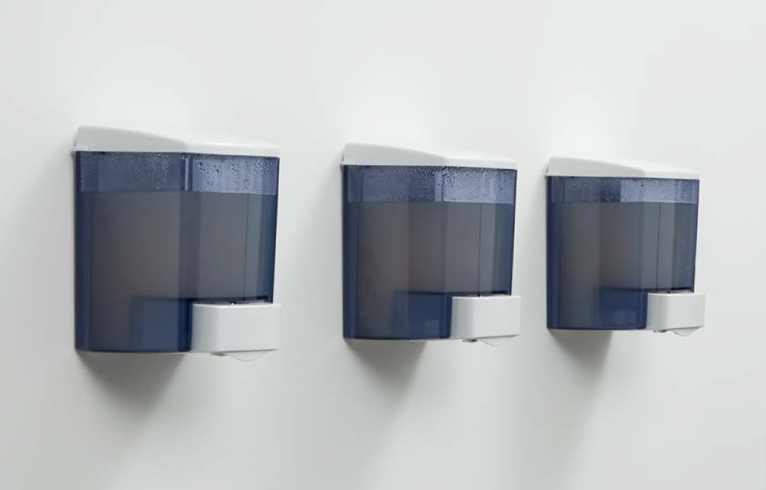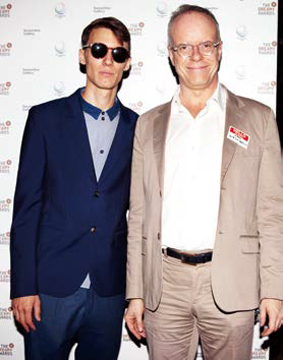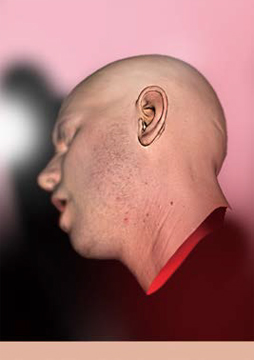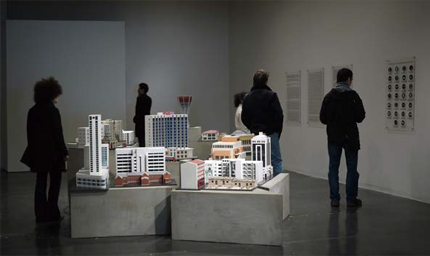Five Emerging Artists
| November 11, 2012 | Post In LEAP 17

JOSH KLINE
To the keen eye of a New Yorker, Josh Kline’s work seems very “New York,” but not disdainfully so. Rather, through minimal sculptural works inspired by the aesthetics of the mass-market commodity, Kline highlights and pulls from the idiosyncratic blend of desperation, celebrity, and soul-suckingness that defines what it means to live and be a cultural producer in New York City. Sleep is for the Weak takes three Bodum French Press cafetiéres and sticks convoluted waves of chewed Dentyne Ice gum into the vestibule where one would normally find coffee grinds. Each is filled with a different performance-enhancing drink, such as Red Bull, Coke Zero, or Vivarin. Share the Health (Assorted Probiotic Hand Gels) fills three institutional-style soap dispensers with probiotic jelly, infused with cultures swabbed from probably very germ-ridden places such as a Chase Bank ATM, or the G train— perhaps the most annoyingly unreliable train that uniquely only services Brooklyn. Perhaps Kline’s work speaks to a built-in self-defeat, one similar to trying to make it big in a city that can only offer dreams and career aspirations.
Josh Kline lives and works in New York and is represented by 47 Canal, which will present a solo exhibition of his work in October at Frieze Frame in London. His work has been included in exhibitions at SculptureCenter, White Columns, 179 Canal, PERFORMA, Gavin Brown’s Enterprise, Taxter & Spengemann, X Initiative, Artists Space, and Guild & Greyshkul in New York; Galerie Christine Mayer, Munich; IMO, Copenhagen; and West, The Hague.

ED FORNIElES
Ed Fornieles, who lives and works in London, is an artist whose medium defies easy categorization, though the roots of which are located in performance, participatory art, sculpture, and video. Evincing the uniquely multifaceted nature of Fornieles’ practice are the “Dreamy Awards,” his recent event at the Serpentine Gallery in Hyde Park, London. A fictional award ceremony, the night is the meeting point of the lives of hundreds of amateur actors cast to play fictional characters or semi-fictionalized versions of themselves. Many of the actors and actresses are professional or personal contacts of Fornieles. Personally, I was cast as “Helen Starkey,” an up-and-coming screenwriter convinced that she’s the voice of her generation, who also moonlights as a fashion writer and avant-garde clothing connoisseur. Fornieles gives his thespians several plot points to enact throughout the night. My favorite was to pitch an idea for my new show to an investment banker and ask for a major lump of money— which I did, somewhat awkwardly, on camera, and seconds after I walked into the Serpentine’s gates.
Interesting here is Fornieles’ consideration of social experiences as networks, and specifically ones that can be manipulated in real time and space. The structure of such is similar to that of Facebook, where, clearly, we negotiate and cultivate our identities online. By rendering this structure in real life, the gravity of our online actions is curiously laid bare.
A graduate of Oxford University and the Royal College of Art, Fornieles is represented by Carlos Ishikawa in London. He will debut “Characterdate,” a semi-fictional dating network, with Carlos Ishikawa at Frieze Frame in London in October 2012.

ED ATKINS
Recently, while watching a Joan Jonas performance layering live sound and video feeds, I was struck thinking about the comparative dearth of young artists who inventively use video, and the abundance of young artists using archaic media such as Super 8, Polaroids, and other celluloid film. Why the hell are we making work with slide projectors in 2012, I wondered?
The British artist Ed Aktins is a prime example of one who pays heed— with, of course, some much needed skepticism— to historical moments in film, and specifically Structuralism, every intellectual’s favorite film moment of the twentieth century. Yet, Atkins importantly contemporizes many moody Structuralist motifs, working in high definition video to contemplate the death of the medium in tandem with the death of the individual, the corporeal, and the material. In the fall of 2012 Atkins will present Us Dead Talk Love at Chisenhale Gallery in London, a project comprising a two-channel video of a pair of cadavers in conversation, waxing philosophical on “immanence, representation, and narcissism.”
Atkins is represented by Isabella Bortolozzi Gallery, Berlin, and Cabinet Gallery, London. Recent exhibitions include “SOUNDWORKS” at ICA, London; “The Imaginary Museum,” Kunstverein Munchen; a solo presentation at Bonn Kunstverein; the Mindaugas Triennial: Baltic Triennial, Vilnius, Lithuania; the International Experimental Film and Video Festival, Zagreb; and “Memory Marathon” at the Serpentine Pavilion. Upcoming solo presentations will be mounted at MoMA PS1, New York, in January 2013; Galerie Isabella Bortolozzi, Berlin, February 2013; and Temple Bar Gallery, Dublin, February 2013.

AHMET ÖGÜT
Perhaps one of the most challenging tasks incumbent upon artists today is to render international politics in a form relatable to both general and art world audiences. Work in such a vein pulls from and builds upon the canon of art history while simultaneously relating to our daily lives— either task being more or less insurmountable. Born in Diyarbakir, Turkey in 1981, the Amsterdam-based artist Ahmet Öğüt has gained international acclaim for rendering the most complex political and art-world concerns in broadly relatable, at times humorous terms. Among his first projects was a stop motion video documenting the artist placing custom-cut pieces of paper onto cars, turning them into nearly trompe l’oeil police and taxi vehicles. His 2009 commission for the Venice Biennale’s Turkish Pavilion replicated miniature buildings destroyed by bombings— some by acts of terrorism and some not— installed in a room with a dropped ceiling, forcing the viewer to become omniscient spectator. Öğüt’s most recent project, titled “The Silent University,” is a roving, multilingual pedagogical program that has found home at the Tate Modern from November until the end of 2012. “The Silent University” meditates on the political nobility of silence and is organized by professional asylum seekers and refugees.
A guest artist at the Rijksakademie in Amsterdam from 2007-2008, Öğüt has recently mounted solo exhibitions that include “Modern Essays 1: Across the Slope,” SALT, Istanbul, 2011; “Once upon a time a clockwatcher during overtime hours,” Fondazione Giuliani, Rome; “Stones to Throw,” Kunsthalle Lissabon, Lisbon; “Exploded City / MATRIX 231,” The MATRIX Program at the UC Berkeley Art Museum; “Ricochet #4,” Museum Villa Stuck, Munich; “Speculative Social Fantasies,” Artspace Visual Arts Centre in Sydney; and “Mutual Issues, Inventive Acts,” Kunsthalle Basel. Selected group exhibitions include the 2012 Liverpool Biennial; the 12th and 9th Istanbul Biennials; the 4th Moscow Biennial; the 2011 Asian Art Biennial, Taichung; Performa 09, New York; and the 5th Berlin Biennial for Contemporary Art.

CECILE B. EVANS
Having studied Theater at New York University, Belgian-American artist Cecile B. Evans moved to Paris in 2006 to pursue a career in acting. At an audition for what would have been her first major role, Evans bombed her performance. “The casting director looked at me and asked me if I gave a shit,” the artist said to me. “I realized at that point that I didn’t.” This telling, albeit awkward, moment catalyzed Evans’ evolution from actress to artist. Though her career has technically changed, her interests have predominantly stayed the same. In her work, Evans frequently waxes upon the production and value of emotions in contemporary society— yet rather than manipulate or create them on the screen, she now contextualizes them through a fine art practice. For her “Schirmer Collages,” Evans screen-captures intimate moments in Meryl Streep movies in which Streep is embracing a man and titles them to reflect tear-jerker catchphrases popularized by the given movie. She then prints these images and overlays them with Schirmer test strips on the figures’ eyes. (Schirmer test strips are a medical device commonly used to test tear production in the eyes of humans and animals.) With a subtly comical effect, Evans juxtaposes the rational, scientific test strip with the emotive pop image of Meryl Streep.
The 2012 recipient of Frieze Foundation’s Emdash Award— which comes with a special public project commission for the Frieze Art Fair, a cash prize, and a three-month residency at Gasworks in London— Evans is working on a new series of performance-based works involving new hologram technology. For her Frieze Art Fair commission, Evans has prepared an audioguide of the fair featuring the subjective commentaries of a panel of five people from non-art backgrounds, such as a rabbi and a cat biologist. The audioguide panel is tied together by a holographic host found at various sites throughout the fair.


